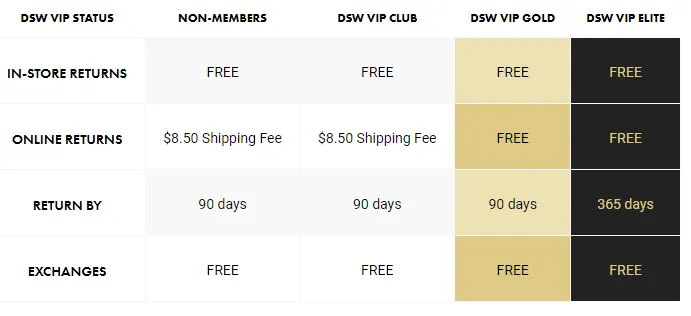
AI-powered delivery date estimates to boost conversion
Give shoppers peace of mind and protect and grow your bottom line
Personalized tracking experiences to build brand loyalty
Returns and exchanges management to mitigate fraud and reward best customers
Proactive communication to drive customer lifetime value
Delivery claim management to tackle fraud and build trust
The Complete Return Policy Guide for eCommerce Retailers
%20(7).webp)
With reverse logistics being a $428 billion industry in the U.S. alone, it’s critical for retailers to have an ecommerce return policy that works. In fact, the right return solution and policy have become critical to both the decision making process and customer loyalty.
More than 60% of consumers will consider the return policy before making a purchase. What’s more, 76% of first-time buyers that had an “easy” or “very easy” returns experience said they would shop with that retailer again.
Given the importance of returns, we analyzed the published return policies of 197 U.S. retailers to set a baseline for the industry. The report also highlights best-in-class examples of more sophisticated, personalized approaches to returns that signal what we believe to be the future of the industry.
What follows is our return policy guide, based on the findings from our report. So, whether you’re starting from scratch or looking to keep your existing policy current with today’s best practices, here’s everything you need to know about writing a successful ecommerce return policy for your company.
What is a return policy, and why is it important?
Your return policy describes the circumstances under which your business will accept returned merchandise from customers, as well as the methods you’ll use to collect returns and issue refunds.
Not only does creating a clear return policy build trust with customers, it’s a powerful financial tool that allows your company to avoid revenue loss through unnecessary or fraudulent returns.
What is a good return policy versus what is a standard return policy?
Not all return policies are created equally. Taking the time to craft an above average return policy versus a standard return policy can contribute to your business’s competitive advantage.
Here are a few ways to differentiate your return policy from more standard offerings.
Return window
The return window refers to the amount of time customers have to return items they’ve purchased, usually starting from the delivery date of the purchased item. Return windows can be standard across all customers or variable under certain circumstances.
Standard
The standard return policy offers a 30-day window for returns, with some exceptions like Final Sale items. 39% of retailers studied have a 30-day return policy.
Above average
A good return policy provides greater flexibility—even sometimes after 30 days—to loyal or target customers. There are creative ways to extend a return policy to ensure retailers are still meeting their bottom line.
As an example of a best-in-class return window policy, take a look at DSW, which expands return windows for certain members of its tiered loyalty program. With DSW, members have to hit a certain purchase threshold to reach higher-tiered status. Although more purchases may come with more returns, those costs are typically recouped during the lifetime of the customer.

Return method
Return policies also need to describe how customers should get the item back to the retailer. Does the retailer have a store network for in-person returns or do they only accept returns that are mailed back to their nearest distribution center?
Standard
The standard return policy offers both in-store and mail-in return methods. If a brand does not have its own physical store footprint, it ought to tap into a return location network to make it easy for customers to drop off returns at local Walgreens, Simon Malls, UPS drop-off locations, and more.
Above average
An excellent return policy goes beyond in-store and mail-back return options, also offering at least one modern, convenient option, like printerless returns, boxless returns, or curbside returns.
Of all the companies studied, 33% offer what we consider to be modern, convenient return methods (a.k.a. a good return policy).
Return initiation channels
How will you allow customers to initiate return requests? The different channels you make available may affect how satisfied customers are with the returns process.
Standard
The standard return policy requires customers to reach out directly via phone, email, chat tool, or web form, or includes a return label in every box.
As you can imagine, this baseline is not very convenient for customers and limits the amount of control and transparency retailers can have of the process, as well as being a burden on support teams. Luckily, many retailers have opted for more seamless initiation channels that also provide retailers greater visibility into return trends—characteristics of a good return policy.
Above average
A good return policy allows customers to initiate returns from an easily-accessible online portal, sometimes even included in a comprehensive membership profile system. An online returns portal or order lookup system is used by:
- 91% of Fortune 50 retailers
- 52% of omnichannel sellers
- 63% of D2C brands
(Editor’s note: Narvar’s platform is trusted by 800+ top retailers, including YETI, Levi’s, Neiman Marcus, Horizn Studios and more. If you’re a retailer interested in Narvar’s online returns portal, please schedule a demo with one of our post-purchase experience experts.)
Refund options
Arguably one of the most important parts of the return process is the refund. Through which methods will you offer customers refunds after they complete their returns?
Standard
A standard return policy has refunds available via store credit and/or the customer’s original payment method.
Above average
In addition to offering both refund options, an exceptional return policy initiates refunds within 7 days.
Bonus tip! A great way for retailers to set themselves apart when it comes to their return policy is to set clear expectations around their refund timing. Many retailers confusingly blur the lines between when the refund is processed and when the refund will be posted by the bank.
Provide both of these date ranges to set proper expectations and decrease customer queries as a result. As an example, you may say your warehouse processes the refund request within 7 days after receipt and then it may take the bank up to 2 weeks to post the payment.
Return fees and charges
The way you set return fees and charges shouldn’t be a financial decision alone. Savvy retailers use fees as a way to incentivize desired behaviors among shoppers.
Standard
A standard return policy requires the customer to cover return shipping fees and/or restocking fees.
Above average
A good return policy uses free return shipping as a way to encourage consumer behaviors that will benefit the retailer. For instance, take Saks Fifth Avenue, which includes the following motivator: “To ensure your item is covered by our free return policy, returns must be initiated within 14 days of the ship date. Returns initiated after 14 days will have a $9.95 return charge deducted from your refund.”
Saks Fifth Avenue is one of a handful of retailers that uses free return shipping as a way to entice consumers to return packages faster, making it more likely the returned item can get back into inventory quickly and be resold for profit.
VIP benefits
As seen in the DSW example above, your return policy can play a role in enticing customers to join your VIP or loyalty programs, benefiting your company through repeat sales.
Standard
A standard return policy is one-size-fits-all, regardless of who the customer is.
Above average
A good return policy has added flexibility or better perks for VIP shoppers or loyalty program members (can be tiered based on the program’s structure).
What should I write in the return policy?
The guidelines above should give you a starting point for your return policy, but be conscious of not over-promising customers a returns experience you can’t regularly deliver and scale.
To some degree, this requires an awareness of the costs you incur for returns and the internal resources you have for processing them. Offering refunds consistently within 5-7 days, for example, requires a fairly sophisticated reverse logistics network to successfully achieve.
How do I create/write a return policy?
If you’re looking for more tips on writing the perfect policy for your business, use our return policy examples or a return policy template as a starting point.
Ask yourself:
- Does this policy encompass all of the different return scenarios our company faces?
- Is this return policy financially sustainable for our business?
- How does this return policy compare with our competitors’ policies?
- Is this policy legal, taking local, state, and federal requirements into consideration?
- How can we improve this policy to better incentivize the kinds of activities and customer relationships we want to promote?
Finally, be sure to revisit your return policy periodically to make sure it’s best serving your business and customers.
Where do I put the return policy on my website?
Visibility is the key to return policy placement, though what that means may look different from company to company.
At a minimum, you should have a link to your return policy in your website’s footer. However, it’s also a good idea to include information about returns on your product description pages, in addition to linking to your policy from your website’s navigation bar and/or top banner.
Based on our research, 64% of the Fortune 50 retailers studied both mention returns in their product description pages and link to their return policies from the navigation bar or banner, compared to 46% of omnichannel participants and 39% of D2C brands.
By contrast, just 18% of Fortune 50 retailers use their websites’ footer as the only place from which they link their returns policy, compared to 34% of omnichannel sellers and 26% of D2C brands.
Enterprise vs. small business return policy
Understandably, Fortune 50 retailers do have a leg up when it comes to setting customer-friendly return policies. According to our research:
- 27% offer VIP policies, vs. 9% of omnichannel sellers and 7% of D2C brands.
- None of the Fortune 50 retailers surveyed charge return shipping fees, vs. just 45% of omnichannel sellers and 22% of D2C brands.
However, there are still ways small- and medium-sized businesses (SMBs) can compete:
- Turn your size into an advantage by offering a level of personalization in the returns process that’s difficult for larger competitors to match at scale.
- Leverage VIP programs to drive loyalty and help offer a best-in-class experience to those of your customers that matter to your bottom line.
Smart retailers use these and other opportunities to leverage their return policy and process as part of a positive customer lifecycle experience. By following the above standards and tips, any retailer can implement a customer-friendly offering.
For more return policy insights, download our new Returns Benchmarks Report here.
























